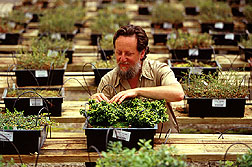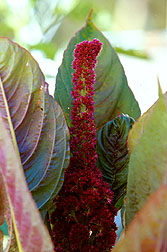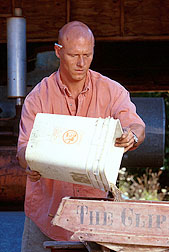Seed-Savers Unite
There's nothing more basic to agriculture than collecting seeds from a crop and replanting them the next season. Documenting how well the seeds grow brings science to the venture. Share the results, and you have education; sell the seeds, and you add business to the equation.
A unique informal alliance between the Agricultural Research Service and a group of organic farmers pulls these components together in a manner that may benefit scientists, growers, and consumers.
The Farmer Cooperative Genome Project (FCGP) based in Junction City, Oregon, seeks to increase the diversity of crop seeds offered for sale to small farmers and gardeners, teach organic farmers how to regenerate seed, and eventually provide the ARS National Plant Germplasm System (NPGS) with additional seed and information.
"The purpose of the NPGS is to retain as much of the natural diversity of crop plants as possible," says ARS horticulturist Richard M. Hannan. "Plant breeders use these plants to develop new crop varieties that offer better disease resistance or improved nutrition or that grow in different environments from existing varieties."
Hannan leads the Western Regional Plant Introduction Station in Pullman, Washington, and serves informally as liaison between ARS and the FCGP.
The germplasm system is a network of 26 repositories nationwide that preserve and regenerate seed and other reproductive tissues—known as germplasm—of crop plants and their wild relatives. The system houses more than 400,000 accessions comprising more than 10,000 species. An accession is a genetically distinct group of plants, such as a crop variety or wild subspecies that has been added to a collection.
|
|
But providing breeders with these genetic resources is a mammoth task. After a number of years—which can range from just a few, for crops like onions, to several decades for hearty seeds like lentils and peas—the accessions must be grown and new seeds collected and stored again in a repository.
Backup supplies of these collections are also sent to a long-term storage facility ARS operates in Fort Collins, Colorado. Ideally, each accession is grown out and characterized so breeders have information about the plants—but there is not always enough staff to collect these details.
An Idea Germinates
J.J. Haapala, an Oregon organic seed grower, realized that small farmers and the germplasm system could help each other. "It struck me that there was a huge opportunity for individuals to participate in safeguarding our plant resources," he says.
Farmers would benefit by taking advantage of a greater diversity of seeds than they might otherwise have access to, while the germplasm system could have many more hands to carry out its mission. "Four of every five traditional crop seed varieties available just 10 years ago are no longer sold," Haapala says.
The project began in 1998 with a grant awarded by the U. S. Department of Agriculture's Fund for Rural America. Haapala also works as director of research and education for Oregon Tilth, a nonprofit organization advocating sustainable agriculture.
So far, more than 300 farmers, seed producers, home gardeners, and scientists have joined the FCGP.
"After someone indicates interest, we send a survey to find out that person's land capacity, experience with seeds, and desired crops," Haapala says. About 80 people have returned the surveys.
Haapala serves as a distribution point and interface between the various repositories and growers. Working with several of the ARS germplasm management sites, he has requested about 570 accessions covering about 50 species.
But, Haapala cautions, the project is not a free seed program for gardeners. Participants must follow rigorous guidelines established by ARS scientists to provide pertinent information on plant growth and development. The farmers are free to use plants they like to develop into new varieties. They can keep excess seed and fruit.
A Source of the Unusual
|
|
An eventual goal of the project is to develop an economically viable cooperative of organic growers producing a wide diversity of seeds for anyone interested in growing unique crops.
Hannan and Haapala believe everyone could benefit. "Many of these farmers are interested in heirloom varieties and traditional crops that might not be getting much attention from customary germplasm users, such as breeders and botanists," Hannan says.
Interest in unusual crops could be wide-ranging, agrees Joseph Postman, an ARS plant pathologist at the National Clonal Germplasm Repository in Corvallis, Oregon. The Corvallis site stores, for example, 250 ancient pear varieties.
"We have pears that ripen earlier than the normal harvest season, old English pears that provide a fermented beverage of interest to some microbreweries, and pears with Siberian or Manchurian ancestry that could extend production into cold climates where there is no commercial pear production," says Postman.
"A pear tree can live more than 100 years, so each heirloom pear tree planted by a farmer essentially becomes a mini-repository—a future source for that cultivar."
NPGS staff will benefit from the project by receiving information they wouldn't otherwise have the opportunity to collect. An example would be data on how a specific variety grows without pesticides in a cool climate such as Oregon's Willamette Valley. "This might be the first information gathered on a particular accession," says Hannan.
"The key is developing trust between the curators and farmers," Hannan notes. He says curators are like parents in their protectiveness over their accessions. They are eager to teach farmers about the specific protocols necessary to maintain genetic integrity. And the arrangement could be a real money-saver, since it costs up to $350 each time an accession is grown out for some species.
Haapala also sees the relationship between organic growers and ARS as a primary benefit. "Some growers have seeds produced and saved for generations that they could contribute to the germplasm system," he says. "Everyone will benefit from this combined effort to preserve our heritage."—By Kathryn Barry Stelljes, Agricultural Research Service Information Staff.
This project is part of Plant, Microbial, and Insect Genetic Resources, Genomics, and Genetic Improvement, an ARS National Program (#301) described on the World Wide Web at http://www.nps.ars.usda.gov/programs/cppvs.htm.
Richard M. Hannan is at the USDA-ARS Western Regional Plant Introduction Station, 59 Johnson Hall, Washington State University, Pullman, WA 99164-6402; phone (509) 335-1502, fax (509) 335-6654.
Joseph D. Postman is at the USDA-ARS National Clonal Germplasm Repository, 33447 Peoria Rd., Corvallis, OR 97333; phone (541) 750-8712, fax (541) 750-8717.
"SEED-SAVERS UNITE" was published in the October 1999 issue of Agricultural Research magazine.









